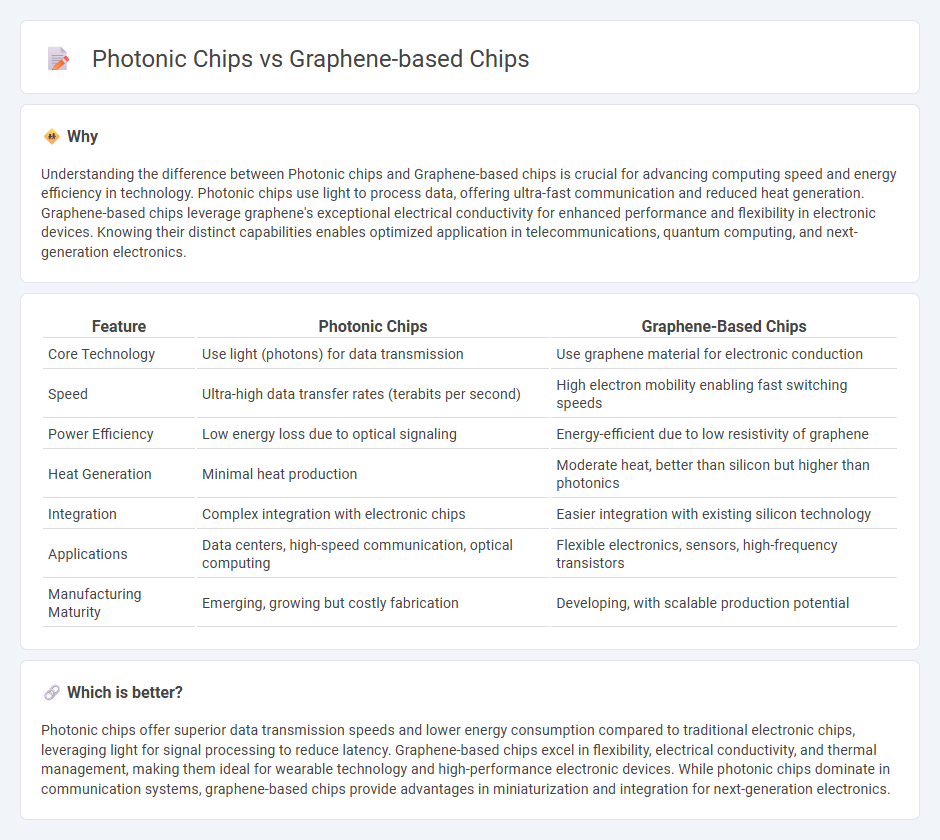
Photonic chips leverage light to transmit data at ultra-high speeds with low energy consumption, making them ideal for advanced computing and telecommunications. Graphene-based chips utilize the remarkable electrical conductivity and flexibility of graphene to enable faster processing and enhanced durability in electronic devices. Explore the unique advantages and potential applications of both technologies to understand their roles in shaping the future of computing.
Why it is important
Understanding the difference between Photonic chips and Graphene-based chips is crucial for advancing computing speed and energy efficiency in technology. Photonic chips use light to process data, offering ultra-fast communication and reduced heat generation. Graphene-based chips leverage graphene's exceptional electrical conductivity for enhanced performance and flexibility in electronic devices. Knowing their distinct capabilities enables optimized application in telecommunications, quantum computing, and next-generation electronics.
Comparison Table
| Feature | Photonic Chips | Graphene-Based Chips |
|---|---|---|
| Core Technology | Use light (photons) for data transmission | Use graphene material for electronic conduction |
| Speed | Ultra-high data transfer rates (terabits per second) | High electron mobility enabling fast switching speeds |
| Power Efficiency | Low energy loss due to optical signaling | Energy-efficient due to low resistivity of graphene |
| Heat Generation | Minimal heat production | Moderate heat, better than silicon but higher than photonics |
| Integration | Complex integration with electronic chips | Easier integration with existing silicon technology |
| Applications | Data centers, high-speed communication, optical computing | Flexible electronics, sensors, high-frequency transistors |
| Manufacturing Maturity | Emerging, growing but costly fabrication | Developing, with scalable production potential |
Which is better?
Photonic chips offer superior data transmission speeds and lower energy consumption compared to traditional electronic chips, leveraging light for signal processing to reduce latency. Graphene-based chips excel in flexibility, electrical conductivity, and thermal management, making them ideal for wearable technology and high-performance electronic devices. While photonic chips dominate in communication systems, graphene-based chips provide advantages in miniaturization and integration for next-generation electronics.
Connection
Photonic chips leverage light for data transmission, significantly enhancing speed and bandwidth, while graphene-based chips utilize graphene's exceptional electrical conductivity and thermal properties to improve performance and energy efficiency. Both technologies converge in next-generation computing hardware, where integrating photonic and graphene-based components facilitates ultra-fast optical interconnects and low-power electronic operations. This synergy promises transformative advancements in data centers, telecommunications, and high-performance computing systems.
Key Terms
Electron mobility
Graphene-based chips exhibit exceptionally high electron mobility, often exceeding 200,000 cm2/V*s at room temperature, which vastly outperforms traditional silicon and even many photonic materials. Photonic chips leverage photons instead of electrons, enabling faster data transmission speeds but do not directly rely on electron mobility for their operation. Explore the detailed advantages and applications of graphene versus photonic chips in cutting-edge electronics and computing technologies.
Bandgap engineering
Graphene-based chips exhibit tunable electronic properties through bandgap engineering by introducing defects or applying electric fields, enabling improved transistor performance and flexibility in nanoelectronics. Photonic chips leverage bandgap engineering in semiconductor materials like silicon or indium phosphide to control light propagation for high-speed optical communication and signal processing. Explore the latest advancements in bandgap engineering to understand the potential of graphene and photonic chips in next-generation technologies.
Optical interconnects
Graphene-based chips leverage the extraordinary electrical conductivity and optical transparency of graphene to enhance optical interconnects by enabling ultra-fast signal transmission with minimal energy loss. Photonic chips utilize light to transfer data, offering high bandwidth and low latency that surpass traditional electronic interconnects, crucial for next-generation computing and telecommunications. Explore the latest advancements in graphene and photonic technologies to understand their impact on optical interconnect performance and future applications.
Source and External Links
World's 1st graphene semiconductor could power future quantum computers - Researchers have developed the world's first functional graphene-based semiconductor, enabling transistors that operate at terahertz frequencies--ten times faster than current silicon-based chips--due to graphene's superior electron mobility and less resistance.
Researchers Create First Functional Semiconductor Made From Graphene - Georgia Tech scientists have created a graphene semiconductor with ten times the electron mobility of silicon, compatible with existing microelectronics processing, marking a viable alternative as silicon approaches its performance limits.
Faster computers: First graphene semiconductor paves the way - The first practical graphene semiconductor solves the critical "band gap problem," enabling it to function like traditional semiconductors and opening the door to next-generation, ultra-fast, energy-efficient electronics.
 dowidth.com
dowidth.com